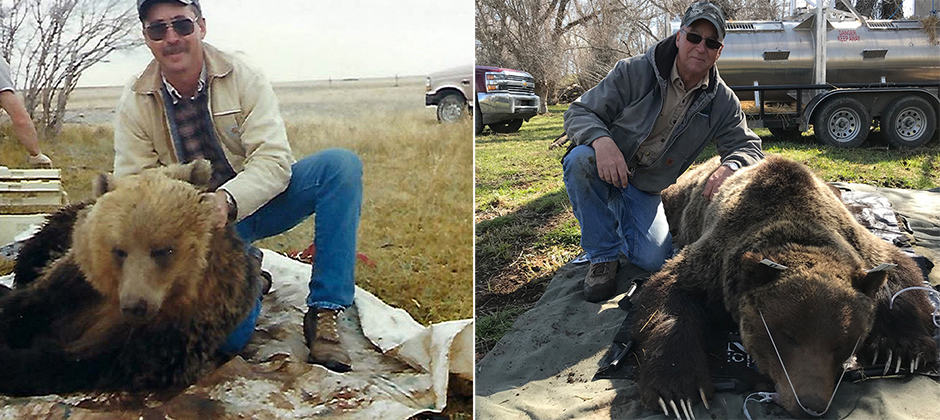Share this article
A Reunion on Montana’s Rocky Mountain Front
A quarter-century after the U.S. Fish and Wildlife Service listed the grizzly bear (Ursus arctos) as a threatened species in the Lower 48 states, bears began frequenting the Rocky Mountain Front. This was the eastern edge of the Northern Continental Divide Ecosystem, one of five remaining grizzly populations. Wildlife Services specialist Mike Hoggan recalls that more and more grizzly bears were showing up in 1997.
That spring, he was investigating a sheep depredation west of Dupuyer near Browning with Montana Fish, Wildlife and Parks staff. Over three nights, his foot snares live-captured four bears: three 2-year-olds and one sub-adult male. All were tagged and relocated, but not before Hoggan posed with one anesthetized young female bear — a photo op he couldn’t resist.
Hoggan explains subsequent changes as the grizzly bear population increased and expanded their range. No longer can a carcass be used over several nights to capture the bear that likely caused the depredation. Today the baited foot snares generally can be set for only one or two nights because leaving them longer risks drawing in many more bears that had nothing to do with predation.
This May, Hoggan and MFWP were setting a culvert trap and foot snares about 300 yards from the site of a calf-depredation in which a grizzly bear was deemed the probable predator. He watched a sow with one bear cub run off when Hoggan’s dog approached the pair. Given the mid-morning timing, he surmised these were the responsible predators. That night trail cameras caught the yearling cub uprooting the snares.
After another night, Hoggan discovered the male cub in a foot snare and transferred him to the family-culvert trap, big enough for two bears. The remaining snares were uprooted and trashed, a nearby healthy cow had been killed but not eaten, and Hoggan could see the sow pacing the tree line, watching the captured cub. He knew he had to catch the sow that night because the cub would be released on-site within 24 hours, a concern for the ranchers.
He set multiple foot snares near the culvert-trapped cub. The next morning Hoggan was relieved to find the sow in a foot snare but was surprised to discover she was the same two-year-old he had last encountered 22 years earlier, not 20 miles from this site. This being her first depredation, MFWP relocated both the grizzly bears but not before Hoggan memorialized the reunion. He says he’s pleased she looked healthy and, now that she sports a GPS collar, he will know where she is in the future.
Header Image: Wildlife Specialist Mike Hoggan of Wildlife Services-Montana poses with the grizzly bear he captured for relocation in 1997 and 2019. ©Courtesy photo








